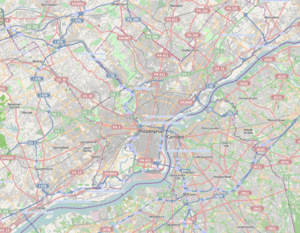Institute for Colored Youth
|
Institute for Colored Youth (former site) | |
|
| |
   | |
| Location | 915 Bainbridge St., Philadelphia, Pennsylvania |
|---|---|
| Coordinates | 39°56′31″N 75°9′28″W / 39.94194°N 75.15778°WCoordinates: 39°56′31″N 75°9′28″W / 39.94194°N 75.15778°W |
| Architect | Edward Fay |
| Architectural style | Italianate |
| MPS | Philadelphia Public Schools TR |
| NRHP Reference # | 86003324 |
| Significant dates | |
| Added to NRHP | December 4, 1986[1] |
| Designated PHMC | 1991[2] |
The Institute for Colored Youth was founded in 1837 in Philadelphia, Pennsylvania, United States. After moving to Delaware County, Pennsylvania, and changing its name to Cheyney University, it continues as the oldest African-American school of higher education, although degrees were not granted by Cheyney until 1913. The second site of the Institute for Colored Youth at Ninth and Bainbridge Streets in Philadelphia was added to the National Register of Historic Places in 1986. It is also known as the Samuel J. Randall School, and is a three-story, three-bay brick building built in 1865, in the Italianate-style[3]
The Institute was founded by Richard Humphreys, a Quaker philanthropist who bequeathed $10,000, one-tenth of his estate, to design and establish a school to educate people of African descent. Born on a plantation in the West Indies, Humphreys came to Philadelphia in 1764, where he became concerned about the struggles of free African Americans to make a living. News of a race riot in 1829 prompted Humphreys to write his will, in which he charged thirteen fellow Quakers to design an institution "to instruct the descendents of the African Race in school learning, in the various branches of the mechanic Arts, trades and Agriculture, in order to prepare and fit and qualify them to act as teachers...."
Using the money Humphreys bequeathed, the Quakers formed an organization in 1837. For several years, they experimented with agricultural and industrial education, as well as trade apprenticeships for African-American children. By 1851, the Managers, as the Quakers came to be called, instead decided to focus on Humphreys's wish to train African-American children to become teachers. In 1852, the Managers opened the first Institute for Colored Youth building at 716–718 Lombard Street in Philadelphia.[4]
Although operated by the Quaker Board of Managers, the faculty of the Institute for Colored Youth consisted entirely of African-American men and women. The Institute contained both Boy's and Girl's High Schools, as well as a Preparatory School. The school provided a classical education to young African Americans in Philadelphia, with a curriculum including advanced mathematics, sciences, English, philosophy, various social sciences, and classical languages.[4]
By 1861, the Managers recognized a need for a better facility for their growing school. After an extensive fundraising campaign, the Managers purchased a lot at 915 Bainbridge Street. The new Institute for Colored Youth building opened on March 9, 1866. It was capable of holding twice as many students as the original school and had facilities such as a lecture hall and chemistry laboratory.[4]
In 1902 the Institute moved to George Cheyney's farm, 25 miles (40 km) west of Philadelphia, and afterward the name "Cheyney" became associated with the school.[5]
Notable alumni
- Julian F. Abele
- Lucy Addison
- Octavius Valentine Catto
- Rebecca Cole[6]
- John Wesley Cromwell (graduated in 1864)[7]
- James B. Dudley
- Josephine Silone Yates
References
- ↑ National Park Service (2009-03-13). "National Register Information System". National Register of Historic Places. National Park Service.
- ↑ "PHMC Historical Markers". Historical Marker Database. Pennsylvania Historical & Museum Commission. Retrieved December 10, 2013.
- ↑ "National Historic Landmarks & National Register of Historic Places in Pennsylvania" (Searchable database). CRGIS: Cultural Resources Geographic Information System. Note: This includes B. Mintz (July 1986). "Pennsylvania Historic Resource Survey Form: Institute for Colored Youth" (PDF). Retrieved 2012-07-03.
- 1 2 3 "History of the Institute for Colored Youth" (The Institute for Colored Youth in the Civil War Era" "...a great thing for our people"), Villanova University.
- ↑ Institute for Colored Youth
- ↑ "Rebecca Cole (c. 1846-1922)", The Institute for Colored Youth in the Civil War Era, Villanova University.
- ↑ William J. Simmons, Henry McNeal Turner, Men of Mark: Eminent, Progressive and Rising, G. M. Rewell & Company, 1887, p 898-907

